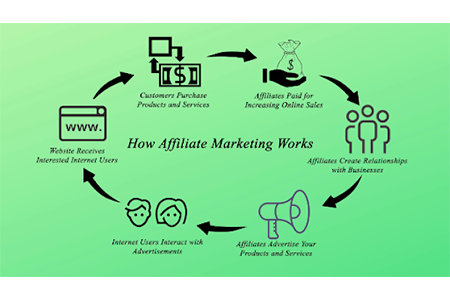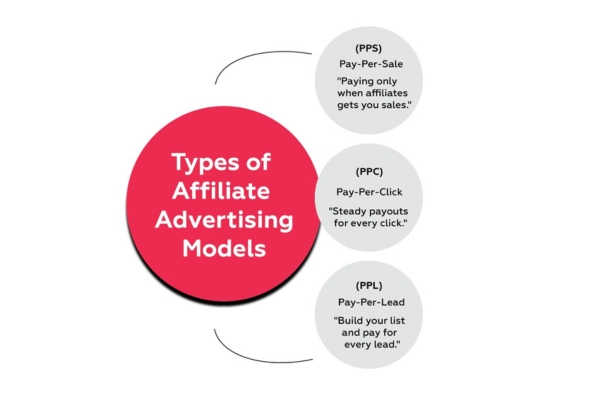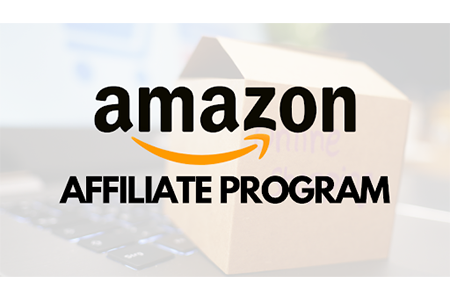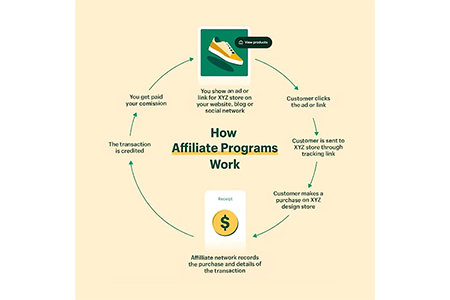Table Of Content
- 1. Introduction
- 2. Understanding Affiliate Advertising
- 3. How Affiliate Advertising Works
- 4. Types of Affiliate Advertising Models
- 5. How to choose the right affiliate advertising model
- 6. How to Get Started with Affiliate Advertising
- 7. Examples of Successful Affiliate Advertising Campaigns
- 8. Conclusion
Introduction
Affiliates have become a powerful tool in the digital advertising arsenal and have gained significant prominence in recent years. They are a performance-based marketing strategy where businesses collaborate with third-party publishers, known as affiliates, to promote their products or services. This mutually beneficial arrangement ensures that affiliates are compensated only when they drive successful conversions, making it an attractive option for both businesses and affiliates.
Understanding Affiliate Advertising
Affiliate advertising is a performance-based marketing strategy that involves a three-way partnership between:
1. Advertiser
The business or organization that offers the product or service to be promoted. The advertiser sets the commission rate and provides the affiliate with marketing materials, such as banners, text links, and product descriptions.
2. Affiliate
The individual or entity that promotes the advertiser's product or service. Affiliates can be bloggers, social media influencers, website owners, or even individuals with a large following. They use their platforms to reach potential customers and encourage them to make a purchase.
3. Consumer
The end-user who makes a purchase after being influenced by the affiliate's promotion. The consumer may discover the product or service through the affiliate's website, social media post, email, or other marketing channels.
How Affiliate Advertising Works?

The affiliate marketing process can be broken down into four key steps:
Step 1: Affiliate Signs Up for Programs or Networks
Affiliates join affiliate programs or networks that represent various advertisers. These platforms provide them with tools, resources, and tracking mechanisms to promote products effectively.
Step 2: Affiliate Promotes the Product
Affiliates use their unique affiliate links to promote the advertiser's products or services on their websites, social media channels, or through email marketing.
Step 3: Consumer Makes a Purchase
When a consumer clicks on the affiliate link and makes a purchase, the affiliate's unique identifier is tracked, allowing the advertiser to attribute the sale.
Step 4: The Advertiser Pays the Affiliate
The advertiser pays the affiliate a commission based on the agreed-upon terms, typically a percentage of the sale or a fixed amount per lead.
Types of Affiliate Advertising Models

There are three primary affiliate advertising models, each with its own unique benefits and drawbacks:
1. Pay-Per-Sale (PPS)
How it works: Affiliates earn a commission only when a consumer makes a purchase.
Benefits:
- Higher potential earnings: Affiliates can earn substantial commissions for each sale.
- Focused on results: This model incentivizes affiliates to drive conversions.
Drawbacks:
- Lower conversion rates: Products with higher value or longer sales cycles may have lower conversion rates.
- Risk of no earnings: Affiliates may not earn a commission if the consumer doesn't complete the purchase.
2. Pay-Per-Click (PPC)
How it works: Affiliates receive a commission for each click on their affiliate link, regardless of whether a purchase is made.
Benefits:
- Consistent income: Affiliates can earn a steady stream of income from clicks.
- Traffic generation: This model is effective for generating traffic to the advertiser's website.
Drawbacks:
- Lower potential earnings: Commissions per click are typically lower than per sale.
- Less focused on conversions: Affiliates may not be as incentivized to drive sales.
3. Pay-Per-Lead (PPL)
How it works: Affiliates are compensated for each lead they generate, such as email sign-ups or contact form submissions.
Benefits:
- Lead generation: This model is ideal for businesses that prioritize lead generation over immediate sales.
- Versatility: Leads can be used for various marketing purposes, such as email marketing and retargeting.
Drawbacks:
- Lower conversion rates: Leads may not always convert into sales.
- Potential for spam: Affiliates may generate low-quality leads or spam.
How to choose the right affiliate advertising model
The best affiliate advertising model for your business depends on your goals, products or services, and target audience. Consider the following factors when making your decision:
- Product value: For high-value products, a PPS model may be more suitable.
- Conversion rates: If your products have low conversion rates, a PPC or PPL model might be a better option.
- Lead generation: If generating leads is your primary goal, a PPL model is a good choice.
- Target audience: Consider the preferences and behaviors of your target audience when selecting a model.
By understanding the different affiliate advertising models and their characteristics, businesses can choose the most effective approach to achieve their marketing objectives.
How to Get Started with Affiliate Advertising
How to Get Started with Affiliate Advertising
For businesses looking to implement affiliate advertising in their strategy, here are some essential steps:
- Choose the Right Affiliate Program: Select a program that aligns with your business goals, target audience, and products or services.
- Identify Suitable Affiliates: Look for affiliates with a relevant audience and a track record of success in promoting similar products.
- Set Clear Goals and Expectations: Define your objectives, such as increasing sales, generating leads, or improving brand awareness.
- Monitor and Optimize Performance: Track the performance of your affiliate campaigns and make adjustments as needed to maximize your return on investment.
Examples of Successful Affiliate Advertising Campaigns
Here are the three most widely successful affiliate campaigns that lead the business to a huge boost in revenue.
Amazon Associates Program

The Amazon Associates Program is one of the most well-known and widely used affiliate programs in the world. It allows affiliates to promote a vast range of products available on Amazon.com and earn commissions on qualifying purchases. This program has been particularly successful due to:
- Wide product selection: Amazon offers a diverse range of products, making it easy for affiliates to find products that align with their audience's interests.
- Brand recognition: Amazon is a highly recognizable brand, which can enhance the credibility of affiliate promotions.
- Robust tracking system: The Amazon Associates program provides affiliates with accurate tracking tools to measure their performance.
- Global reach: Amazon operates in multiple countries, allowing affiliates to target a global audience.
Shopify Affiliate Program

Shopify's affiliate program offers a unique opportunity for affiliates to earn commissions by referring new merchants to their e-commerce platform. This program has been successful due to:
- Growing e-commerce market: The e-commerce industry is experiencing rapid growth, making Shopify a valuable platform for businesses.
- Recurring revenue: Affiliates can earn recurring commissions from merchants they refer, as long as the merchants remain active on Shopify.
- Strong brand reputation: Shopify is known for its user-friendly platform and excellent customer support.
- Affiliate marketing tools: Shopify provides affiliates with marketing materials and resources to help them promote their program effectively.
Fashion and Beauty Influencer Affiliates

Influencer marketing in the fashion and beauty industries has become a powerful marketing channel. They often collaborate with brands to promote their products through social media, blog posts, and other content. This type of affiliate marketing has been particularly successful due to:
- Authenticity: Influencers have a genuine connection with their followers, which can make their recommendations more trustworthy.
- Engagement: Influencers often have high levels of engagement with their audience, making their promotions more effective.
- Niche expertise: Fashion and beauty influencers have a deep understanding of their respective industries, allowing them to provide valuable insights to their followers.
- Visual appeal: The visual nature of fashion and beauty products lends itself well to social media platforms.
These are just a few examples of successful affiliate advertising campaigns. By studying these case studies, businesses can gain valuable insights into effective affiliate marketing strategies and identify opportunities to leverage this powerful tool for growth.
Conclusion
Affiliate advertising is a powerful, performance-driven marketing approach. By partnering with the right affiliates, your business can reach new audiences, drive sales, and maximize ROI. If you're ready to take your marketing to the next level, contact our advertising agency today and integrate affiliate advertising into your strategy for success!



